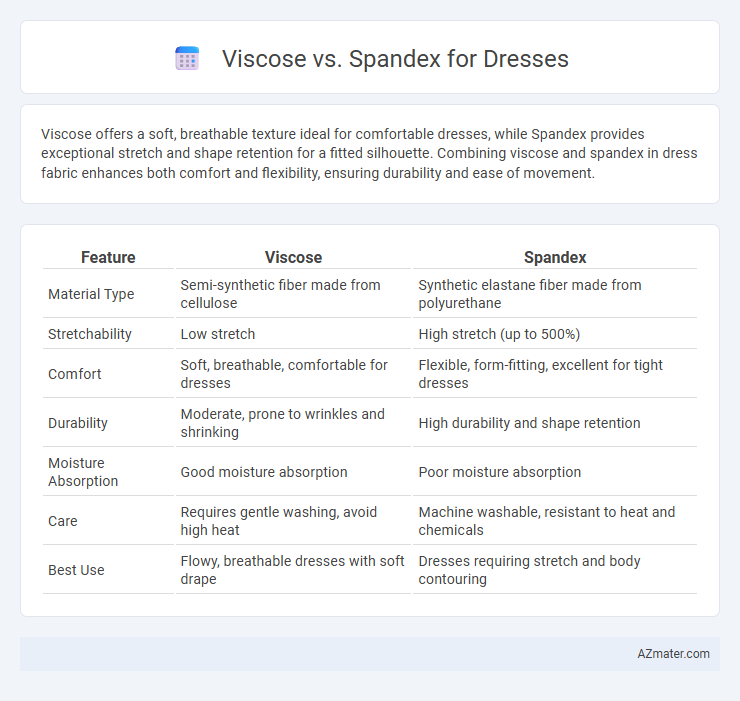Viscose offers a soft, breathable texture ideal for comfortable dresses, while Spandex provides exceptional stretch and shape retention for a fitted silhouette. Combining viscose and spandex in dress fabric enhances both comfort and flexibility, ensuring durability and ease of movement.
Table of Comparison
| Feature | Viscose | Spandex |
|---|---|---|
| Material Type | Semi-synthetic fiber made from cellulose | Synthetic elastane fiber made from polyurethane |
| Stretchability | Low stretch | High stretch (up to 500%) |
| Comfort | Soft, breathable, comfortable for dresses | Flexible, form-fitting, excellent for tight dresses |
| Durability | Moderate, prone to wrinkles and shrinking | High durability and shape retention |
| Moisture Absorption | Good moisture absorption | Poor moisture absorption |
| Care | Requires gentle washing, avoid high heat | Machine washable, resistant to heat and chemicals |
| Best Use | Flowy, breathable dresses with soft drape | Dresses requiring stretch and body contouring |
Introduction to Viscose and Spandex
Viscose is a semi-synthetic fiber made from regenerated cellulose, offering a soft, breathable, and smooth texture ideal for dresses that require comfort and drape. Spandex, also known as elastane, is a synthetic fiber renowned for its exceptional elasticity and stretch recovery, enhancing fit and flexibility in fitted dresses. Combining viscose with spandex blends the natural feel of viscose with the stretch of spandex, creating versatile, comfortable, and form-fitting garments.
Fabric Composition and Origins
Viscose is a semi-synthetic fabric derived from regenerated cellulose fibers sourced primarily from wood pulp, offering a soft and breathable texture ideal for dresses. Spandex, also known as elastane, is a fully synthetic fiber made from polyurethane, known for its exceptional elasticity and stretch, often blended with other fabrics to enhance fit and comfort. Combining viscose with spandex in dress fabrics balances natural softness with flexible stretch, resulting in garments that provide both comfort and form-fitting durability.
Texture and Feel: Viscose vs Spandex
Viscose offers a soft, smooth texture with a natural drape that feels breathable and comfortable against the skin, making it ideal for flowing dresses. Spandex provides a stretchy, elastic feel that enhances fit and movement, giving garments a snug yet flexible quality. Combining viscose with spandex blends the softness of viscose with the flexibility of spandex, resulting in dresses that are both comfortable and form-fitting.
Breathability and Comfort Comparison
Viscose offers superior breathability due to its natural cellulose fibers, making it ideal for dresses worn in warm weather by allowing air circulation to keep the wearer cool. Spandex, known for exceptional elasticity, provides a snug fit but less breathability since it traps heat and moisture, which may reduce comfort during long wear. Combining viscose with a small percentage of spandex often balances comfort and stretch, enhancing both breathability and fit in dress fabrics.
Stretchability and Flexibility Factors
Viscose offers a soft, breathable texture with moderate stretch, ideal for comfort but limited in elasticity compared to spandex. Spandex provides superior stretchability and flexibility, allowing dresses to maintain shape and accommodate movement without sagging. Combining viscose and spandex enhances both comfort and dynamic fit, making the fabric blend popular for form-fitting dresses.
Durability and Longevity
Viscose offers a soft, breathable texture but tends to lose strength and shape over time, making it less durable for frequent dress wear. Spandex provides excellent elasticity and resistance to wear, maintaining fit and durability even after multiple washes. Dresses blended with spandex typically exhibit enhanced longevity due to spandex's ability to retain stretch and resilience.
Ease of Care and Maintenance
Viscose dresses require gentle hand washing or dry cleaning to maintain their softness and avoid shrinking, making their care more delicate. Spandex blends offer superior ease of maintenance, as they are typically machine washable and resistant to wrinkles and shrinking. Choosing spandex for dresses ensures long-lasting fabric resilience with minimal upkeep, ideal for everyday wear and convenience.
Environmental Impact and Sustainability
Viscose, derived from wood pulp, often involves chemically intensive production processes that contribute to deforestation and water pollution, raising concerns about its environmental footprint. Spandex, a synthetic fiber made from petrochemicals, is non-biodegradable and relies on fossil fuels, resulting in significant carbon emissions and microplastic pollution during washing. Sustainable alternatives include lyocell or recycled spandex blends, which offer lower ecological impacts while maintaining stretch and comfort in dress fabrics.
Best Uses for Dresses: Viscose vs Spandex
Viscose offers a soft, breathable fabric ideal for flowy, lightweight dresses that provide comfort in warm weather. Spandex excels in stretchability and shape retention, making it perfect for body-hugging or activewear dresses that require flexibility and durability. Combining viscose with spandex creates versatile dresses that balance breathability with stretch, enhancing both comfort and fit.
Choosing the Right Fabric for Your Dress
Viscose offers a soft, breathable texture ideal for flowy, comfortable dresses, while spandex provides exceptional stretch and shape retention, making it perfect for fitted styles. Consider viscose when prioritizing breathability and drape, and choose spandex blends for durability and flexibility in form-fitting designs. Selecting the right fabric depends on desired comfort, silhouette, and occasion suitability.

Infographic: Viscose vs Spandex for Dress
 azmater.com
azmater.com